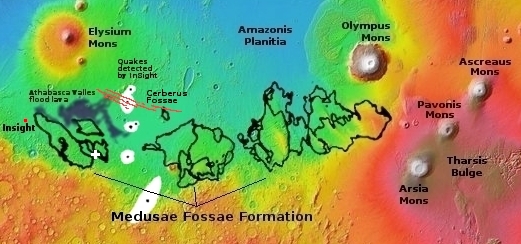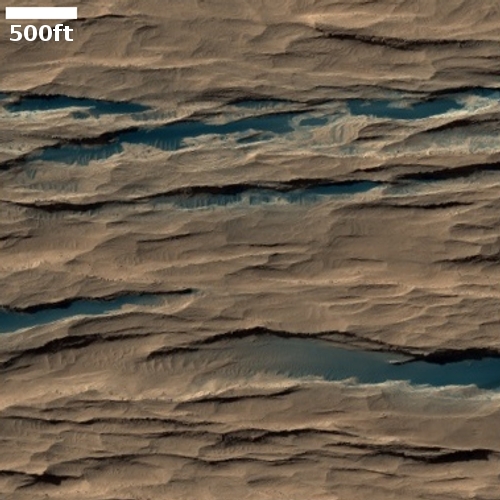A clue to the Martian history of volcanic eruptions
Anyone who has taken even a single glance at a map of Mars cannot help but recognize that the red planet was once engulfed with repeated gigantic volcanic eruptions able to build numerous volcanoes larger than anything seen anywhere else in the solar system.
The cool image to the right, rotated, cropped, and enlarged to post here, provides a clue into those past eruptions, now thought to have been active for more than several billion years, with the most recent large activity ending several tens of millions of years ago. The photo was taken on May 7, 2021 by the high resolution camera on Mars Reconnaissance Orbiter (MRO), and shows just one tiny portion of the vast Medusae Fossae Formation, the largest thick volcanic ash deposit on Mars, about the size of India and what scientists think is the source of most of the planet’s dust.
What makes this picture interesting are the dark layers in the lower hollows. They indicate that this deposit was placed down in multiple eruptions, some of which produced material that appears dark blue in MRO images, and suggest that eruption was different than previous and subsequent eruptions.
The white cross on the overview map below notes the location of this picture in the Medusae Fossae Formation.

On MRO images, red sugguts dust, while dark blue suggests coarse material, either large-grained sand or rocks. Thus, this dark layer suggests the eruption produced larger material, requiring a more powerful blast to fling that material into the sky.
The larger particles in the lower layers could also mean that over time, the pressure from overlying layers has squeezed this layer’s volcanic dust into larger particles. That the squeezing is so specific to this layer still suggests that the eruptions that produced it were different.
That’s about all I, an amateur scientist, can glean from this image. I suspect the professionals can glean more, but I also suspect they will be making their own guesses, though based on far greater knowledge.
Either way, the image illustrates that the era of volcanism on Mars was long and vast. It is difficult to imagine what the planet was like when these volcanoes were active. It certainly wasn’t the relatively quiet place we see today.
On Christmas Eve 1968 three Americans became the first humans to visit another world. What they did to celebrate was unexpected and profound, and will be remembered throughout all human history. Genesis: the Story of Apollo 8, Robert Zimmerman's classic history of humanity's first journey to another world, tells that story, and it is now available as both an ebook and an audiobook, both with a foreword by Valerie Anders and a new introduction by Robert Zimmerman.
The print edition can be purchased at Amazon or from any other book seller. If you want an autographed copy the price is $60 for the hardback and $45 for the paperback, plus $8 shipping for each. Go here for purchasing details. The ebook is available everywhere for $5.99 (before discount) at amazon, or direct from my ebook publisher, ebookit. If you buy it from ebookit you don't support the big tech companies and the author gets a bigger cut much sooner.
The audiobook is also available at all these vendors, and is also free with a 30-day trial membership to Audible.
"Not simply about one mission, [Genesis] is also the history of America's quest for the moon... Zimmerman has done a masterful job of tying disparate events together into a solid account of one of America's greatest human triumphs."--San Antonio Express-News
Anyone who has taken even a single glance at a map of Mars cannot help but recognize that the red planet was once engulfed with repeated gigantic volcanic eruptions able to build numerous volcanoes larger than anything seen anywhere else in the solar system.
The cool image to the right, rotated, cropped, and enlarged to post here, provides a clue into those past eruptions, now thought to have been active for more than several billion years, with the most recent large activity ending several tens of millions of years ago. The photo was taken on May 7, 2021 by the high resolution camera on Mars Reconnaissance Orbiter (MRO), and shows just one tiny portion of the vast Medusae Fossae Formation, the largest thick volcanic ash deposit on Mars, about the size of India and what scientists think is the source of most of the planet’s dust.
What makes this picture interesting are the dark layers in the lower hollows. They indicate that this deposit was placed down in multiple eruptions, some of which produced material that appears dark blue in MRO images, and suggest that eruption was different than previous and subsequent eruptions.
The white cross on the overview map below notes the location of this picture in the Medusae Fossae Formation.

On MRO images, red sugguts dust, while dark blue suggests coarse material, either large-grained sand or rocks. Thus, this dark layer suggests the eruption produced larger material, requiring a more powerful blast to fling that material into the sky.
The larger particles in the lower layers could also mean that over time, the pressure from overlying layers has squeezed this layer’s volcanic dust into larger particles. That the squeezing is so specific to this layer still suggests that the eruptions that produced it were different.
That’s about all I, an amateur scientist, can glean from this image. I suspect the professionals can glean more, but I also suspect they will be making their own guesses, though based on far greater knowledge.
Either way, the image illustrates that the era of volcanism on Mars was long and vast. It is difficult to imagine what the planet was like when these volcanoes were active. It certainly wasn’t the relatively quiet place we see today.
On Christmas Eve 1968 three Americans became the first humans to visit another world. What they did to celebrate was unexpected and profound, and will be remembered throughout all human history. Genesis: the Story of Apollo 8, Robert Zimmerman's classic history of humanity's first journey to another world, tells that story, and it is now available as both an ebook and an audiobook, both with a foreword by Valerie Anders and a new introduction by Robert Zimmerman.
The print edition can be purchased at Amazon or from any other book seller. If you want an autographed copy the price is $60 for the hardback and $45 for the paperback, plus $8 shipping for each. Go here for purchasing details. The ebook is available everywhere for $5.99 (before discount) at amazon, or direct from my ebook publisher, ebookit. If you buy it from ebookit you don't support the big tech companies and the author gets a bigger cut much sooner.
The audiobook is also available at all these vendors, and is also free with a 30-day trial membership to Audible.
"Not simply about one mission, [Genesis] is also the history of America's quest for the moon... Zimmerman has done a masterful job of tying disparate events together into a solid account of one of America's greatest human triumphs."--San Antonio Express-News



But are the schools there good?
Appreciate the information. Mars is a wonderful place! For a geologist; volcanoes and glaciers and ice, oh my! Botanists and the like may not be so enthralled. It does seem like Mars has a higher percentage of volcanic terraforming than, say, Earth. And I live in the American West: nothing but volcanic activity, here. Just curious why Mars seems to have a planetary thyroid condition.
“The Glacier growing inside Mount St. Helens’ Crater”
(2004)
https://youtu.be/L2ivI-WIunc
13:30